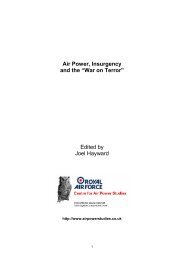Air Power, Insurgency and the âWar on Terrorâ - Prof. Joel Hayward's ...
Air Power, Insurgency and the âWar on Terrorâ - Prof. Joel Hayward's ...
Air Power, Insurgency and the âWar on Terrorâ - Prof. Joel Hayward's ...
Create successful ePaper yourself
Turn your PDF publications into a flip-book with our unique Google optimized e-Paper software.
Starting with a Blank Sheet: Principles of War for a New Century<br />
There were some interesting ideas here, <str<strong>on</strong>g>and</str<strong>on</strong>g>, in fact, <str<strong>on</strong>g>the</str<strong>on</strong>g> <str<strong>on</strong>g>Air</str<strong>on</strong>g> University exclaimed proudly:<br />
“The principles of <str<strong>on</strong>g>Air</str<strong>on</strong>g> Warfare stem from Mitchell, Arnold, <str<strong>on</strong>g>and</str<strong>on</strong>g> Knerr, more notably than<br />
from Frederick or Napole<strong>on</strong>, <str<strong>on</strong>g>and</str<strong>on</strong>g> <str<strong>on</strong>g>Air</str<strong>on</strong>g> Force thinking needs no Old Testament text for<br />
justificati<strong>on</strong>.” 472 Unfortunately, despite <str<strong>on</strong>g>the</str<strong>on</strong>g> bold talk, <str<strong>on</strong>g>the</str<strong>on</strong>g> <str<strong>on</strong>g>Air</str<strong>on</strong>g> Force failed to follow up. The<br />
first official Basic Doctrine Manual of 1953 listed <str<strong>on</strong>g>the</str<strong>on</strong>g> same principles <str<strong>on</strong>g>the</str<strong>on</strong>g>n being used in<br />
Army doctrine manuals. Today, US <str<strong>on</strong>g>Air</str<strong>on</strong>g> Force doctrine still lists nine principles; <str<strong>on</strong>g>the</str<strong>on</strong>g> same<br />
tired list proposed by Fuller <str<strong>on</strong>g>and</str<strong>on</strong>g> modified by <str<strong>on</strong>g>the</str<strong>on</strong>g> US Army nearly a century ago. 473 The<br />
airmen who copied <str<strong>on</strong>g>the</str<strong>on</strong>g>se l<str<strong>on</strong>g>and</str<strong>on</strong>g> warfare principles laboured to make <str<strong>on</strong>g>the</str<strong>on</strong>g>m into something<br />
useful for <str<strong>on</strong>g>the</str<strong>on</strong>g> <str<strong>on</strong>g>Air</str<strong>on</strong>g> Force; not always successfully. The discussi<strong>on</strong> of mass, for example,<br />
makes little sense in an age of precisi<strong>on</strong>-guided muniti<strong>on</strong>s.<br />
It is now time to start with a blank sheet. War has changed so dramatically since 1916,<br />
when Fuller first enumerated his strategic principles, that <str<strong>on</strong>g>the</str<strong>on</strong>g> c<strong>on</strong>tinual attempts to shape<br />
<str<strong>on</strong>g>and</str<strong>on</strong>g> s<str<strong>on</strong>g>and</str<strong>on</strong>g> <str<strong>on</strong>g>the</str<strong>on</strong>g>se round pegs so <str<strong>on</strong>g>the</str<strong>on</strong>g>y’ll fit into square holes are becoming useless.<br />
To <str<strong>on</strong>g>the</str<strong>on</strong>g> extent that Principles of War are at all useful to modern military <str<strong>on</strong>g>and</str<strong>on</strong>g> civilian<br />
planners – <str<strong>on</strong>g>and</str<strong>on</strong>g> I think that <str<strong>on</strong>g>the</str<strong>on</strong>g>y are – <str<strong>on</strong>g>the</str<strong>on</strong>g>n clearly <str<strong>on</strong>g>the</str<strong>on</strong>g> new envir<strong>on</strong>ment coupled with<br />
revoluti<strong>on</strong>ary transformati<strong>on</strong> in <str<strong>on</strong>g>the</str<strong>on</strong>g> c<strong>on</strong>duct of war dem<str<strong>on</strong>g>and</str<strong>on</strong>g> a fresh start. I <str<strong>on</strong>g>the</str<strong>on</strong>g>refore<br />
propose <str<strong>on</strong>g>the</str<strong>on</strong>g> following list.<br />
1. <str<strong>on</strong>g>Air</str<strong>on</strong>g>, space, cyberspace <str<strong>on</strong>g>and</str<strong>on</strong>g> naval supremacy: The US <str<strong>on</strong>g>and</str<strong>on</strong>g> its closet allies have come to<br />
depend up<strong>on</strong> – to assume – this dominance. They do so for good reas<strong>on</strong>. The US Army<br />
has not had to fight without air superiority since Kasserine Pass in 1943. 474 It has not lost<br />
a soldier to an enemy aeroplane since 1953 during <str<strong>on</strong>g>the</str<strong>on</strong>g> Korean War. It has never had to fire<br />
a surface-to-air missile at an enemy aircraft. The bad guys have never gotten that close.<br />
US <str<strong>on</strong>g>and</str<strong>on</strong>g> allied sea superiority has been equally impressive. Since <str<strong>on</strong>g>the</str<strong>on</strong>g> 1943 victory in <str<strong>on</strong>g>the</str<strong>on</strong>g><br />
Battle of <str<strong>on</strong>g>the</str<strong>on</strong>g> Atlantic during World War II, our dominance at sea has been unquesti<strong>on</strong>ed.<br />
In short, <str<strong>on</strong>g>the</str<strong>on</strong>g> US <str<strong>on</strong>g>and</str<strong>on</strong>g> its allies have been able to deploy forces worldwide, by air or sea, for<br />
over a half-century with virtually no losses. Once those forces have been established in<br />
<str<strong>on</strong>g>the</str<strong>on</strong>g>atre, <str<strong>on</strong>g>the</str<strong>on</strong>g>y have been re-supplied, again by air <str<strong>on</strong>g>and</str<strong>on</strong>g> sea, largely unopposed. 475 Given that<br />
virtually all US military operati<strong>on</strong>s occur abroad, this is very significant. In <str<strong>on</strong>g>the</str<strong>on</strong>g> battlespace<br />
itself, air superiority, <str<strong>on</strong>g>and</str<strong>on</strong>g> indeed, air supremacy, has meant that <str<strong>on</strong>g>the</str<strong>on</strong>g> o<str<strong>on</strong>g>the</str<strong>on</strong>g>r air missi<strong>on</strong>s so<br />
essential to <str<strong>on</strong>g>the</str<strong>on</strong>g> joint force – deep strike, interdicti<strong>on</strong>, close air support, rec<strong>on</strong>naissance,<br />
battle management, airlift <str<strong>on</strong>g>and</str<strong>on</strong>g> air refuelling – have g<strong>on</strong>e largely unimpeded, especially<br />
since <str<strong>on</strong>g>the</str<strong>on</strong>g> Vietnam War over three decades ago.<br />
Cyberspace is a new envir<strong>on</strong>ment that is rapidly becoming a crucial fr<strong>on</strong>t in modern war.<br />
In fact, <str<strong>on</strong>g>the</str<strong>on</strong>g> US <str<strong>on</strong>g>Air</str<strong>on</strong>g> Force has designated a major comm<str<strong>on</strong>g>and</str<strong>on</strong>g> to deal with <str<strong>on</strong>g>the</str<strong>on</strong>g> challenges<br />
192<br />
<str<strong>on</strong>g>Air</str<strong>on</strong>g> <str<strong>on</strong>g>Power</str<strong>on</strong>g>, <str<strong>on</strong>g>Insurgency</str<strong>on</strong>g> <str<strong>on</strong>g>and</str<strong>on</strong>g> <str<strong>on</strong>g>the</str<strong>on</strong>g> “War <strong>on</strong> Terror”





